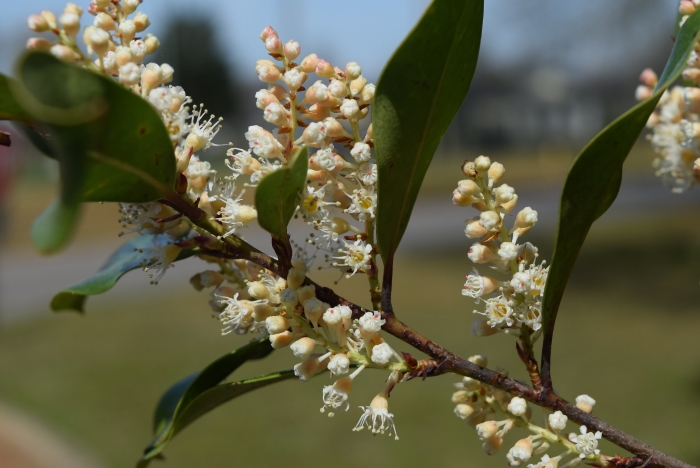Carolina Laurelcherry
(Prunus caroliniana)
Carolina Laurelcherry (Prunus caroliniana)
/
/

Stephanie Harvey
CC BY 2.0
Image By:
Stephanie Harvey
Recorded By:
Copyright:
CC BY 2.0
Copyright Notice:
Photo by: Stephanie Harvey | License Type: CC BY 2.0 | License URL: https://creativecommons.org/licenses/by/2.0/ | Uploader: sgharvey@ymail.com | Publisher: Flickr |






















































Estimated Native Range
Summary
Prunus caroliniana, commonly known as Carolina Laurelcherry, is an evergreen tree native to the Southeastern United States, particularly found in forest edges, open woodlands, and riparian areas. It typically grows to 5–13 meters (16–43 feet) tall and 6–9 meters (20–30 feet) wide. The tree features smooth, red to grayish-brown twigs and glossy, dark green leaves that emit a maraschino cherry-like fragrance when crushed. From late winter to early spring, it produces fragrant white to cream-colored flowers in racemes, followed by small, black cherries that persist through winter and are favored by birds.
Carolina Laurelcherry is valued for its dense, evergreen foliage and fragrant flowers, making it a popular choice for urban planting, border planting, and as a hedge. It is relatively low-maintenance, tolerating a range of soil conditions, though it prefers acidic soils and may develop chlorosis in alkaline soils. It thrives in full sun to part shade and requires medium water with good drainage. While it is hardy in USDA zones 7B through 10A, gardeners should be cautious of its potential invasiveness outside its native range.CC BY-SA 4.0
Carolina Laurelcherry is valued for its dense, evergreen foliage and fragrant flowers, making it a popular choice for urban planting, border planting, and as a hedge. It is relatively low-maintenance, tolerating a range of soil conditions, though it prefers acidic soils and may develop chlorosis in alkaline soils. It thrives in full sun to part shade and requires medium water with good drainage. While it is hardy in USDA zones 7B through 10A, gardeners should be cautious of its potential invasiveness outside its native range.CC BY-SA 4.0
Plant Description
- Plant Type: Tree, Shrub
- Height: 15-20 feet
- Width: 10-15 feet
- Growth Rate: Rapid
- Flower Color: White
- Flowering Season: Winter, Spring
- Leaf Retention: Evergreen
Growth Requirements
- Sun: Full Sun, Part Shade
- Water: Medium
- Drainage: Slow, Medium, Fast
Common Uses
Bank Stabilization, Bee Garden, Bird Garden, Border Plant, Butterfly Garden, Deer Resistant, Drought Tolerant, Fragrant, Hedges, Low Maintenance, Rabbit Resistant, Salt Tolerant, Street Planting
Natural Habitat
Forest edges, open woodlands, and riparian areas within the Southeastern United States
Other Names
Common Names: Carolina Cherry Laurel
Scientific Names: , Prunus caroliniana, Laurocerasus caroliniana, Cerasus caroliniana, Prunus nitida, Bumelia serrata, Chimanthus amygdalina, Padus carolina, Padus caroliniana, Prunus sempervirens
GBIF Accepted Name: Prunus caroliniana (Mill.) Aiton